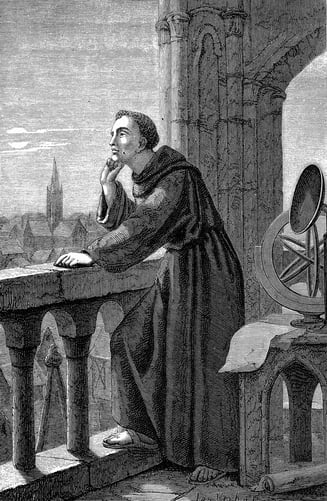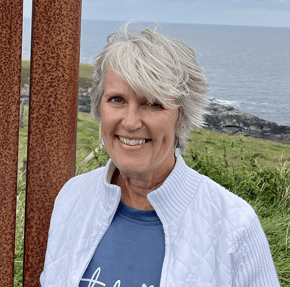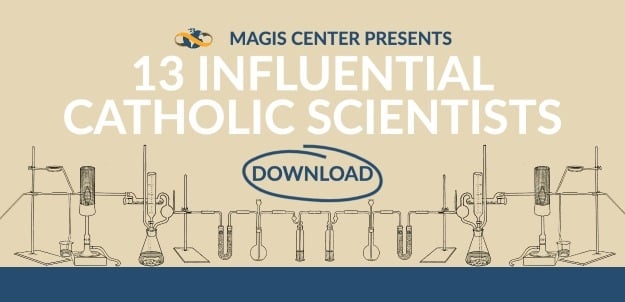"A little learning is a dangerous thing but none at all is fatal."
—Roger Bacon Quoted in Des MacHale, Wisdom (London, 2002)
Roger Bacon (c. 1214-1292), a 13th-century Franciscan monk, is often confused with Sir Francis Bacon (1561-1626), a 16th-century English statesman and philosopher. Although separated by centuries, the confusion is understandable because both men contributed to the emerging empirical approach to knowledge in their time. Sir Francis Bacon is a contender for being the Founder of the modern scientific method (along with Galileo), but Friar Roger Bacon is currently viewed as a forerunner rather than a founder.
 Roger Bacon by Jan Verhas / Public domain via Wikimedia Commons
Roger Bacon by Jan Verhas / Public domain via Wikimedia Commons
Roger Bacon’s Early Life and Education
There are few resources available that fully document Bacon’s early life. Even the dates of his birth are contested, ranging from 1210 to 1220. It is known that his father was a wealthy landowner who supported him during his studies at Oxford, beginning at the age of 13. His studies would have included grammar, logic, and rhetoric (known as the Trivium), followed by geometry, arithmetic, music, and astronomy. He became well-versed in Aristotelian philosophy. It is also believed that during this time, he mastered the science of optics by studying the Greek and Arabic texts available to him.
Bacon was invited to lecture on Aristotelian philosophy at the University of Paris (c 1237-47). Here, Bacon met the French mathematician and physicist Peter Peregrinus, whom he greatly admired. In Bacon's own words:
[Peregrinus] gains knowledge of matters of nature, medicine, and alchemy through experiment, and all that is in the heaven and in the earth beneath...so that nothing may escape him which ought to be known, and that he may perceive how far to reprove all that is false and magical.
In 1248, Bacon returned to Oxford, focusing his studies and lectures on mathematics and natural philosophy. Still supported by his family, he was able to obtain rare books and equipment to aid his investigations. Bacon returned to Paris in 1251, where he continued to lecture as a private scholar. In 1256, he entered the Franciscan order. There is some speculation about Bacon’s choice of the Franciscans over the Dominicans. One possibility is that, at the time, the Franciscans appeared to be more open to the works of Aristotle.
Influenced by Peregrinus and inspired by his study of optics, Bacon began to develop “experimental science,” which he mentions in Part IV of his Opus Maius:
I wish now to unfold the roots on the part of scientia experimentalis, because without experience [experientia] nothing can be known sufficiently.
He firmly believed that this method, rooted in mathematics and related to sense experience, could be used as a foundation for knowing what is true in the natural order—and to promote health and discover new medicines!
Roger Bacon as Educational Reformer
As an experienced teacher, Bacon saw that the university curriculum needed reform. Not only did he think the philosophy and theology of the day inadequately captured the “wisdom of God,” he also thought that natural philosophy (“experimental science”) needed to be included in the university curriculum for the benefit of the students and for the Church.
At the request of Pope Clement IV (whom Bacon had met as Cardinal Guy le Gros de Foulque, Papal ambassador to England), between 1266 and 1268, Friar Bacon quickly wrote three books describing his proposed reforms: the Opus Maius, Opus minus, and Opus Tertium. According to one source:
[Bacon] set out his own new model for a reform of the system of philosophical, scientific, and theological studies, seeking to incorporate language studies and science studies, then unavailable, at the University of Paris. . . . He succeeded in setting out a model of an experimental science on the basis of his study of optics. The latter was used in his extension of experimental science to include new medicines and the general health care of the body.
Unfortunately, Pope Clement IV died in 1268, and it is unlikely he was able to read them.
Sometime in 1279, Friar Bacon returned to Oxford, where he died c. 1280.
Friar Roger Bacon’s Other Contributions
"Half of science is asking the right questions."
—Roger Bacon
Friar Bacon did make contributions in other areas of theology and philosophy. Of note are two works on semiotics, the use of signs and symbols to convey meaning. Bacon’s influential work in this area is considered unique, as described in one scholarly article:
Moreover, Bacon’s work on semiotics is notable for his insistence that things rather than their concepts are the principal significates of words. Together with the work of Dante Alghieri (1265-1321), Bacon’s work on language stands out in virtue of his observations on the evolution of languages. Lastly, Bacon’s linguistic work is noteworthy in virtue of his having stated the basic principle of universal grammar, that is, the principle that there is only one grammar for all languages.
The list of contributions below is related more to his work in the natural sciences.
Did Roger Bacon Invent Gunpowder?
In some publications, it is proposed that Roger Bacon invented gunpowder. What can be confirmed is that he is the first European to write about it. Some historians argue that Roger Bacon created a cipher in his works describing how to make gunpowder, but there is not enough evidence to support this notion. In fact, in his Opus Tertium, he describes how gunpowder, “that deadly mixture,” had already been used in children’s toys (firecrackers!). It is more likely, therefore, that gunpowder was known to him but not invented by him.
Roger Bacon and Optics
Bacon’s fascination with optics began at Oxford, where the Greek and Arab texts on the topic were available. He may have been influenced by Robert Grosseteste with regard to the use of lenses to enhance vision. His observations and experiments later led to the invention of “eyeglasses” or spectacles. Additionally, in the Opus maius, he described how a telescope might be designed:
For we can so shape transparent bodies, and arrange them in such a way with respect to our sight and objects of vision, that the rays will be reflected and bent in any direction we desire, and under any angle we wish, we may see the object near or at a distance. . . So we might also cause the Sun, Moon and stars in appearance to descend here below. . .
Roger Bacon Proposes Calendar Reform
Because of his interest in astronomy, Bacon also proposed a reform of the calendar. His plea to the Pope went unheeded, but the Church did reform the calendar 300 years later! Friar Bacon was again ahead of his time.
Roger Bacon as Forerunner to Scientific Method
It is interesting to note that much of the scholarship concerning Roger Bacon is emerging in our time due to the discovery of certain of his manuscripts. Scholars have argued about Bacon’s role in the generation of the modern scientific method:
More recently, M. Schramm (1998) has argued that Bacon plays a significant role in framing the context for the beginnings of medieval, Renaissance and early modern notions of laws of nature. . . . [Others] have emphasized the need to read Roger Bacon. . . as a medieval philosopher, scientist, and theologian [to] be properly understood.
Despite the debate, for centuries, Roger Bacon was known as Doctor Mirabilis or “wonderful teacher.” He dedicated his life to the pursuit of Wisdom, which he believed God had given to us as a means of achieving both happiness and salvation.
Cover image: Roger Bacon in his observatory at Merton College, Oxford by Ernest Board / CC BY 4.0, via Wikimedia Commons


